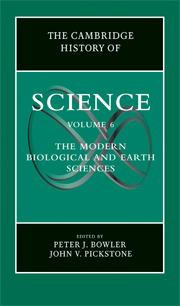Book contents
- Frontmatter
- 1 Introduction
- PART I WORKERS AND PLACES
- PART II ANALYSIS AND EXPERIMENTATION
- 10 Geology
- 11 Paleontology
- 12 Zoology
- 13 Botany
- 14 Evolution
- 15 Anatomy, Histology, and Cytology
- 16 Embryology
- 17 Microbiology
- 18 Physiology
- 19 Pathology
- PART III NEW OBJECTS AND IDEAS
- PART IV SCIENCE AND CULTURE
- Index
- References
10 - Geology
from PART II - ANALYSIS AND EXPERIMENTATION
Published online by Cambridge University Press: 28 November 2009
- Frontmatter
- 1 Introduction
- PART I WORKERS AND PLACES
- PART II ANALYSIS AND EXPERIMENTATION
- 10 Geology
- 11 Paleontology
- 12 Zoology
- 13 Botany
- 14 Evolution
- 15 Anatomy, Histology, and Cytology
- 16 Embryology
- 17 Microbiology
- 18 Physiology
- 19 Pathology
- PART III NEW OBJECTS AND IDEAS
- PART IV SCIENCE AND CULTURE
- Index
- References
Summary
Geology is the name arrived at in the 1820s for a specific approach to the scientific study of the earth’s outer layers. This new science aimed to discover and date the natural history of this three-dimensional ensemble of layered rock, to learn the origins, variety, and provenance of the rock-forming minerals that composed these layers, and to uncover and understand the natural processes and laws that shaped them. The name “geology” came into general use when the new approach it denoted had already been under way for more than a century (as is almost always the case in science). Thus, while it was still an activity without a fixed name, “geology” had already encountered several robust and preexisting competing approaches to studying the earth, each with its own proprietary interest in the phenomenon. Much of the history of geology in the nineteenth and twentieth centuries is a story of conflict and accommodation with these antecedent approaches to the study of the surface of the planet. As a result, most writing on the history of geology – and especially that produced since about 1980 – has embraced the idea that geology emerged and grew as a science through a series of great controversies.
- Type
- Chapter
- Information
- The Cambridge History of Science , pp. 165 - 184Publisher: Cambridge University PressPrint publication year: 2009

